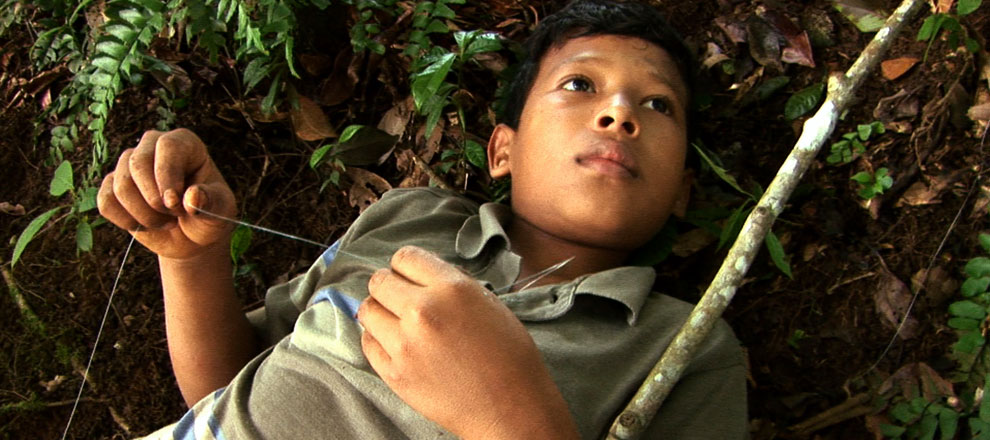When Alfonso Cuarón won
the Best Director Oscar for his groundbreaking work in “Gravity” earlier this year, he not only made history by
becoming the first Hispanic filmmaker to win an Academy Award for directing—he
also cemented himself as a gateway artist for American mainstream
English-speaking audiences to discover lesser known avenues of Latin American
cinema; a whole new wave of moviegoers are now going to back into his filmography,
and will discover titles and themes from a different cultural context (namely a
vision that isn’t the direct by-product of Hollywood). Cuarón’s roots are in
the fiercely independent Mexican cinema movement, especially highlighted by his
earlier films “Sólo Con Tu Pareja”
and “Y Tu Mamá También”, and the Latin
American cinematic discourse as a whole has been flourishing at a rapid pace in
the years since his 1991 feature film debut. Which is why the 30th
Chicago Latino Film Festival takes on even more precedence this year. Spanning
from April 3rd through April 17th in downtown Chicago,
the CLFF continues its march forward with curating a truly diverse program that
ranges from semi-mainstream commercial films to more humble, micro-budget
independent films from all of the Latin Americas and Spain. Here’s a preview of
some of the films at the year’s fest:

Mexico’s “Levantamuertos (Death of the Ordinary)” describes itself as a dark comedy but it plays more
like a morose and cynical short film that was thinned out to a sleepy 82-minutes.
It’s not necessarily a terrible film—it just doesn’t know how to drive home its
themes of social anxiety, relationship struggles and the quest for self-fulfillment.
The story follows Ivan, a quiet bachelor who works in a coroner’s office and
splits his time between (subtly) hitting on the cashier at his local liquor
store and hanging out alone in his apartment, sometimes doing things that are
best left to be seen on screen. During a night of drinking at a local watering
hole, Ivan meets the voluptuous Rosa and after an unsuccessful try at having
sex in Ivan’s car, the pair agrees to get a motel downtown. That’s when
director Miguel Nunez stages an exceptionally uncomforting scene, as Rosa
insists that Ivan continually hit her in the face during intercourse. What
should’ve followed as a twisted tale of guilt ends up being a meandering,
marginal character study: Ivan gives blank looks to the people around him and
occasionally questions the merits of himself and his career. However, there is
a running gag in the second half of the film that involves a pig, which Ivan
cares for in his apartment. There are some interesting moments there, between
Ivan and the pig, as we get a sneak peek into the seriousness of his
self-inflected isolation from the world. But the pig needs its own movie.

The Argentinean documentary “El Árbol De La Muralla (The
Tree That Grows On The Wall)” tells the interesting story of Jack Fuchs, a
Polish survivor from the Holocaust who uprooted to Argentina and continues to
live there nearly 40 years later. Speaking fluent Spanish, Jack engages with
filmmaker Tomás Lipgot in a series of talking head interviews (mostly in his
living room) that reveal an unusual level of comfort between interviewee and
interviewer. In fact, Lipgot implies that each interview segment could’ve
possibly been lost had he not already been engaged in a philosophical
discussion or a related topical question with Jack; there are a couple of
moments when the camera is hastily readjusted for framing and there is also a scene
where the boom operator is revealed during a resetting of a shot. Visually
though, that’s all there is: a talking head. There are some animation sequences
depicting Jack’s horrific memories of the concentration camps but they aren’t
played to a powerful effect; they are more distracting than anything. A more
tactful conceit would’ve been to go smaller in concept, like the still clay
figures in the quietly moving Oscar nominee “The
Missing Picture”. The more striking moments come in archival footage of
Jack, like a scene where he is standing on the streets of the ghetto, sadly
admitting to the camera that to this day, he cannot remember his younger
sister’s face. In the end, “El Árbol” is
a satisfying film, a cathartic discussion on the merits of memory and the art
of sustaining a positive spirit.

“Por Amor En El Caserío
(For Love In The Caserio)” is a bright
and cheery production, even though it falls into pits of afterschool special TV
drama. Set on location in Puerto Rico’s largest public housing project, the
Luis Llorens Torres, “Por Amor” is a contemporary,
loose riff on “Romeo & Juliet” but its real draw is its non-professional
cast of actors, many of whom actually live in the housing project. When Angelo
moves back in with his family in the Caserio, he finds himself in the
crosshairs of doom: he falls in love with Cristal, a pretty theatre student who
happens to be connected to the rival gang that Angelo has already (if not
enthusiastically) aligned himself with. Although the story is predictable
(hello, Shakespeare) and the melodrama kicks into cheesy high gear near the
end, the enthusiastic feelings and charisma from this cast is pretty infectious
and they are fun to watch in their day to day banter amongst neighbors, friends
and rivals. It’s a harmless piece of work and is a small win for low-budget,
communal filmmaking.
Finally, there’s Costa Rica’s “Agua Bendita (Holy Water)”,
which looks at the displaced Nicaraguans who live in a small village within the
Costa Rican border, after fleeing the Sandinista Revolution. Shot on what looks
to be the Panasonic AG-HVX200 camera, “Agua
Bendita” almost looks like a Dogme 95 (the avant-garde style created by Lars
Von Trier) film, with its handheld camera movements, use of the location’s
natural light and its genre-less tone. But this movie wasn’t shot on 35mm film.
Still, it plays out like Von Trier’s “Dogville“,
in that it looks closely and purely at the inhabitants of a community and their
struggle with a coming crisis. In “Dogville”,
Nicole Kidman’s character was on a run from the mob and therefore she
introduced chaos into that town; in “Agua
Bendita”, a pending drought will put these villagers in serious depravity,
with the possibility of fatal results, unless they can successfully bring an
affordable aqueduct to the village. Jumping back and forth between the villagers’
own testimonial asides and the “story” playing out, “Agua Bendita” emerges as a message movie—but a potent one. Living in
a great city like Chicago, with Lake Michigan as a massive water resource, it
can be easy to dismiss or even be unaware of a larger portion of the world’s
struggle to gain access to drinking and cleaning water. In “Agua Bendita”, the vitality of water is re-contextualized for the
eyes of American viewers. There is a key scene between two children that
stresses this. As a little boy prepares to kill an insect, a young girl
advises: “It’s better if you let it go.” The boy responds: “With so many
[insects], I don’t think that for one the world will end.” The girl then says: “No.
But if you get this you will always want to get more.” It’s that kind of moment
that will have viewers studying the theater’s bathroom sinks closely while they
wash their hands after the film’s festival screening.
It’s the kind of eye-opening worldly view that Chicago
Latino Film Festival has consistently brought back to our attention, year after
year.











